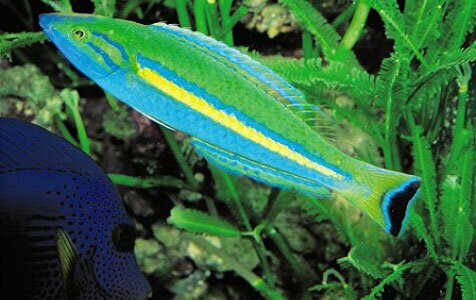Smalltail Pencil Wrasse
From Microcosm Aquarium Explorer
Overview
This is the most-common of the Pencil Wrasses available to aquarists, a fish of extraordinary beauty and modest size.
Although they would seem to be ideally suited for the reef aquarium, the Pseudojuloides spp. are difficult to keep.
Food habit studies do not indicate that they have a specialized diet, but even so, they tend to become emaciated and perish in the aquarium.
Like other wrasses that present feeding challenges (e.g., Tamarin wrasses, leopard wrasses, and ribbon wrasses), they usually do better in a reef tank, where they will find some natural fodder, than in a more sterile aquarium that lacks “live” substrate.
One key to keeping them alive is to provide them with a varied diet and feed them frequently.
Pencil Wrasses are best left to the experienced reefkeepers with larger reef aquariums.
Family: Labridae
Other common name(s):
Native range:
- Indo-Pacific
- Hawaiian Islands
- Society Islands
- Austral Islands
- Izu Islands
- Lord Howe Island
- East Africa
Habitat: It is found in clear lagoons and on outer reef faces and slopes at depths of 2 to 61 m (7 to 201 ft.). It is not common at depths of less than 20 m (66 ft.). The Smalltail Pencil Wrasse is usually found over coral rubble with patches of macroalgae. It is also found in areas of rich stony coral growth. When threatened, Pencil Wrasses will hide among the rubble, bury in the sand, or try to out-swim their adversaries.
Maximum length: 12.3 cm (5 in)
Minimum aquarium size: 284 L (75 gal)
Water: Marine 24 °C (75 °F) - 28 °C (82 °F)
General swimming level: Midwater to bottom.
Feeding
Carnivore. In the wild, these wrasses feed on small, benthic invertebrates (including fan worms, small crustaceans) that they pluck from the substrate without disrupting it.
In the aquarium, they will do best in a larger, well-establish reef aquarium with healthy populations of microfauna on which they can graze.
Offer several feedings each day of meaty foods: Cyclops, Mysis shrimp, reef plankton, enriched brine shrimp, live black worms, high-quality preparations for reef carnivores. May eventually take marine flake foods.
Aquarium Compatibility
A peaceful species that is not a threat to most reef aquarium invertebrates. Will eat small fireworms and may attack small ornamental shrimps.
It is best not to house these wrasses with more aggressive fish tankmates. Avoid housing them with larger dottybacks, Paracirrhites hawkfishes, pugnacious damsels, banana wrasses (genus Thalassoma), larger sand perches, and triggerfishes. Of course, in a larger tank, you may be able to get away with keeping the Pseudojuloides with potential bullies, but make sure the pencil wrasses are in the tank first.
Their elongate form makes them easy prey for a wide range of piscivores, including frogfishes, scorpionfishes, and groupers.
Special Care
Pseudojuloides are proficient jumpers that will leap from open tanks. It is important to provide them with a layer of fine sand, at least 5 cm (2 in.) deep, to bury under.
Some aquarists advocate deworming soon after arrival.
Having a productive refugium attached to the display tank to provide a constant supply of live foods, such as amphipods, may help keep a Pencil Wrasse adequately fed.
Notes
A newly arrived fish may bury itself in the sand bed and seem to disappear for several days.
Initial phase fish are white with a copper-colored dorsum, while terminal phase males are spectacular, with a network of pink lines on the head and pink spots on the orange body.
Females are all orange with a white spot on the nose. This initial phase coloration is common among all the Pseudojuloides spp., except P. atavai.









